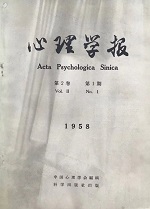|
|
NOTE ON TYPES CHARACTERIZED BY THE COUPLING OF THE HIGHEST NERVOUS ACTIVITY IN CHILDREN BY MEANS OF VERBALLY REINFORCED MOTOR CONDITIONING METHOD
HSU SHU-LIEN AND K'UANG P'EI-TZU (Institute of Psychology, Academia Sinica)
1958, 2 (1):
55-66.
We adopted Ivanov-Smolinsky's method of verbally reinforced motor conditioned reflex to investigate the characteristics of types in couplings of the highest nervous activity in children. This was done in the hope that it would be a start for further investigations of the typology of human highest nervous activity.Subjects Compriseds 43 primary school children of the first and second grades, aged 8—10. There were 3 basic experimental procedures: (1)to establish positive conditioned reflexes by means of a red light and an electric bell respectively, (2) to obtain the extination and restoration of conditioned reflexes formed with the electric bell and, (3) to establish the differentiation phase of a yellow light from the red light. In the mean time, each child was observed and investigated according to a planned outline.Experimental findings indicated that a group of children (10 in number)could not form the positive conditioned reflex. Even when the motor reaction occurred after the experimenter's instructions, it was easily affected by the inhibited reflex. Most of these children were considered by their teachers as pupils who observed disciplinary rules. The greater part of children, according to the principles of equilibrium and mobility, might be divided into 3 groups, namely, those with high equilibrium-mobility (17 in number), those with excitability (5 children) and the weak type (4 children). These characteristics agreed with those found in Ivanov-Smolinsky's laboratory. A small number of children (7), could not be grouped, for the time being, into any type.Experimental results were not always in agreement with observations and investigated materials.This method, to some extent, is able to disclose some characteristics with respect to equilibrium and mobility of the coupling function of children's cerebral cortices. But there is yet no indicator to show the absolute strength of the nervous process. Here, too, the reinforcement principle, as a method, becomes a main problem. For the elder children and adults, to form the conditioned connections through the use of simultaneous association of words and a certain stimulus may not be the principal form to establish the conditioned connection by the aid of words.
Related Articles |
Metrics
|




